
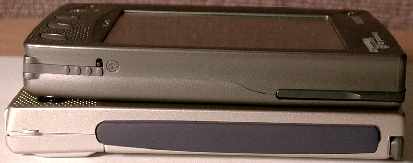
| Official Gadgeteer Hands On
Review: Casio E-15 by Julie Strietelmeier Last date revised: 05/03/99 |
Program Requirements:
Desktop:
Windows 98/95 or NT 4.0
486/66DX or higher processor (Pentium 90 recommended)
16 MB of memory for Win98/95, 32 MB for WinNT
Windows 98/955 or NT 4.0 (NT 4.0 users require Service Pack 3)
10-50 MB of hard disk space
Free serial port
CD-ROM
Instead of only introducing a new PSPC model with a color display, Casio has also just introduced a new black/white model called the E-15. This model has 16meg of RAM, a 16 level gray-scale display and a newly styled case. I've consistently liked Casio's WindowsCE devices better than the others available and this new model isn't an exception. Let's check out the hardware specs first.
Hardware Specs:
Operating system:
Windows CE ver 2.11
Processor:
MIPS VR4111 processor operating at 69 MHz
Memory:
16MB RAM, 16MB ROM
Display:
240 � 320 pixels LCD, FSTN, 16 level gray-scale
One CompactFlash slot Type I/II slot (3.3v)
IrDA port
Power:
2 Alkaline AAA batteries or included NiMH Rechargeable battery pack
AC adapter also included
Back-up Lithium CR2032 battery
Size & Weight:
5" x 3.15" x 0.6"
6.7 oz. (with included batteries)
What you'll notice most about the E-15 the first time that you see it is the case. If we compare it to the Casio E-10/11, it is a bit longer, and thinner. It is also a lighter shade of grey than the E-10/11. I would actually say that it is silver. The sides of the case have purple colored rubberized grips which help you hold on to the unit. I think the E-15 feels a bit more solid than the E-10/11. You can see the pictures below comparing the size of the E-16 with that of an E-11.


The front of the case has an interesting new cursor button. This is a round button that is similar to a joypad. It can be easily pressed in 4 different directions. Up, down, left or right. This button helps you use the E-15 with just one hand. It is easier to use than the Action/Rocker button for scrolling up and down through data. The only thing that I wish this button did that it doesn't is to actually select something when you press the center in. Or, it would be nice if it would pop up the start menu when it was pressed in. I think this button will be popular for games. Especially when/if the Gameboy emulator for the PSPC is finished.
The front of the case also has 3 launch buttons. These buttons will power the unit on and launch the designated application. The top button will launch the built in menu program. The other two buttons will launch the datebook and contacts apps. You can also configure these three buttons to launch different apps if you so desire.
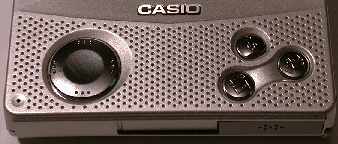
Between the cursor and application buttons is the speaker. Having the speaker on the front of the unit is really nice because sounds don't become muffled with your hand as they do when the speaker is on the back of the unit. The volume of the E-15 is much louder than the E-10/11. At the bottom left of the unit near the cursor button is the microphone. I'm not sure why it was placed it in that location as it seems awkward to hold the unit so that you can press the voice recorder button on the side and talk into the microphone. Although the mic does seem to pick up sound very well anyway that you hold the unit.
On the top of the E-15 is an LED that blinks red when an alarm goes off. You can also set alarms so that this LED is your only notification of an alarm. This is a nice feature for meetings where you wouldn't want a loud alarm to go off.
At the bottom of the E-15 is the serial port. On the E-10/11 there was a little rubber cap that you could put over this connector when you didn't want to sync. Of course, this is the first thing you lost when using the unit. The E-15 has a great sliding door that can slide over the port or out of the way when in use. This is a nice touch that I really like.

The left side of the PDA is pretty busy, it has four buttons, two connectors and one IR port. At the top is the AC adapter connector. This is a very nice addition that was sorely lacking on the E-10/11 units. With the included AC adapter, you can plug it in and use the E-15 without draining the internal batteries. The only bad thing is that when the unit is plugged in this way, it does not recharge the batteries. Below the AC adapter is the Power/Backlight button. This is a pretty small button that I find somewhat hard to press. To do so, I have to use the tip of my thumb or thumbnail. Fortunately, I usually just turn the unit on by pressing the menu launcher button on the front. Holding the Power button in, will toggle the backlight. Below the Power button is the Exit button. This button will exit out of selections or menus. Next comes the Action Rocker/Selection button. This button can be pressed in to select an option or menu selection, or it can be rocked up or down to cycle through selections. The front cursor pad will do this also. Comparing the Action button on the E-15 with the same button on the E-10/11, I found that the E-15's button is recessed a bit more making it ever so slightly more difficult to use. Below the Action button is the Voice Recorder button. Pressing and holding this button will turn the unit on and start recording a voice note. Next in line is the IR port. The E-15 is the first PSPC that I have seen with the IR port on the side of the unit instead of the top. I could see where this new location might be a bit hard to get used to. I rarely use my IR port, but it could matter to people that frequently use their PSPC as a remote control, print files via an IR printer or even beam data to other PSPC users. Then finally there is the ear phone jack (mono). This is a standard sized jack. All of the buttons are recessed and stiff enough so that they can't accidentally be activated. All but the Action button have tactile feedback when pressing them in.

The right side of the unit is bare except for the rubberized grip and stylus holder. The stylus is a baseball bat shaped plastic stylus with green tip. The finger grip portion of the stylus has ridges cut into it to make it easier to hold on to.


On the back of the E-15 is the compact flash slot. The slot is covered with a hinged door. This is the only fragile feeling part of the E-15 that I have noticed. The door is held in place on each side by thin arms. If you weren't careful, I think it would be easy to break this little door off. I really prefer a compact flash slot like the one on the Compaq Aero. It just has an opening that is either filled with a card or plastic slug in the shape of a real card. Getting a card in or out of the E-15 is easy as the door swings out of way. The door can also be removed.

The battery compartments are also on the back of the unit. A slider switch locks or unlocks the battery door so that you can easily remove it. Behind the door is the backup battery and main batteries. The E-15 is rated for 25 hours of battery life (depending on use) and comes with rechargeable batteries which charge while the E-15 is in the cradle. You can also use 2 regular alkaline AAA batteries which is a nice convenience in case you're travelling and are away from a power outlet for charging. During my testing of the E-15, I never had a low battery warning even when listening to quite a few .mp3 songs on a CompactFlash card and using the backlight.
The back of the E-15 also has the reset switch that can be activated by the tip of the stylus.
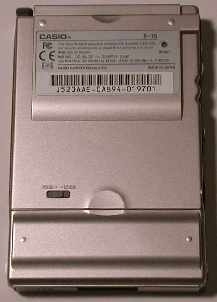
The display on the E-15 has 16 level grey-scale. The E-10/11 had just 4 level grey-scale. This was done for software compatibility with color applications. As for clarity, I think that the E-15 screen is very good. I had said that the E-10/11 screen was the best of all the black/white PSPCs. I think that is still true with the E-15 display being a close second. The only reason why the E-15 isn't the best is because of this new 16 shades of grey. It makes the screen slightly harder to see because some things on the screen are a very light shade of grey. The main problem that I had was that I thought some of the options on the screen were disabled when they weren't. This can be a bit confusing at first. Turning up the contrast level does seem to help this problem.
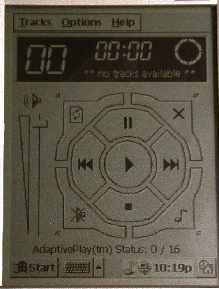
As far writing on the screen, this screen has a slightly more paper-like feel than the Casio E-10/11 has. I personally prefer screens that are more glassy like the Compaq Aero but this is just a personal preference. The E-15s screen is sensitive and easy to write on.
The backlight on the E-15 is just as bright as the E-10/11 which is one of brightest and best backlights of any black/white PSPC.
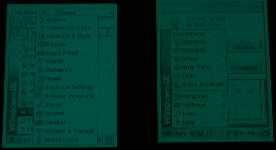 (E-11 on left, E-15 on right)
(E-11 on left, E-15 on right)
Sound quality on the E-15 is very good. I did a test where I put some .mp3 songs on a CompactFlash card and listened to them using Xaudio on both the E-15 and an E-11. I found that the E-15 was slightly louder (at the highest volume setting) and had slightly more treble. The E-15 is not stereo, but it sounds good to me. Since the E-15 has 16 MB of RAM, it can be used as a great .mp3 player. As for voice recordings, the E-15 does an excellent job. Regardless as to which recording format that you use, Mobile Voice, PCM or TrueSpeech, they all sound very clear without hardly any background hissing at all. If you want to use the E-15 as a voice recorder, you'll be very happy with it.
One of the best improvements that the E-15 has over the previous Casio PSPC models is the extra memory. The E-15 has 16 MB of RAM which comes in very handy if you like to install third party applications. Unfortunately, Windows CE applications can be quite large. Having 16 MB is really a necessity. Even if you don't intend to install other applications on your E-15, having that extra RAM will come in handy when you have multiple applications open at once.
What about the overall system speed of the unit? I'm pleased to say that the E-15 seems quite a bit snappier than my E-11. On the E-11, you usually see the hourglass everytime you open an application. On the E-15, you either don't see it, or it flashes up so quick and is gone that you'll probably miss it. Popping up menus and displaying screens also seems to be quicker.
The E-15 cradle is an upgraded version of the cradle that came with the E-10/11 models. The only real difference other than the cradle doubling as the battery charger is that there is now a push button that will eject your E-15 from the cradle and an LED on front. The LED glows red when the unit is charging and changes to green when the unit is completely charged. The E-15 slides into the cradle pretty easily as long as you line up the little ears on each side of the PDA with grooves in the cradle. Removing the PDA requires you to press the eject button and then lift out the unit.
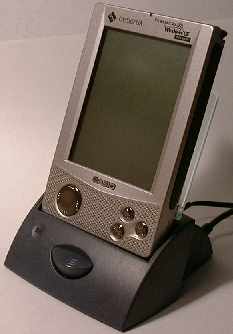
Software Specs:
The Casio E-15 comes with WindowsCE Services 2.2 and a nice software bundle. The included programs are:
Pocket Data Base - Pocket Data Base is a handy database application that you can use anywhere to look up and enter data on your E-15. It allows up to 256 text fields per file and will hold as many records as your Cassiopeia's memory can hold. It also features a text search engine and is compatible with the comma delimited (.csv) files which can be downloaded from your Desktop computer and into your E-15. This is a simple program but I found it quite useful. It would be even better if it had some extra sorting options. Requires installation.
Schedule Viewer - Schedule Viewer makes it easy to view data from Windows CE's built-in Calendar program. Calendar data can be viewed in up to five different formats; Daily, Timetable, Weekly, Monthly and the (3) Month view. This is a nice little program that I found pretty useful. Requires installation.
Landware's Financial Calculator - Designed specifically for real estate, retail and business professionals who need to use Windows CE based CASSIOPEIA E-15 to make fundamental financial decisions quickly and accurately. Requires installation.
Enterprise Harmony '99 from Extended Systems - Synchronize your data with Mircosoft Outlook or Palm Desktop. Enterprise Harmony 99, from Extended Systems, is a powerful way to keep your contacts, schedule, and e-mail up-todate on your new CASSIOPEIA. You can use the software to synchronize Pocket Outlook on you E-15 with Mircosoft Outlook on your desktop. And if your primary personal manager is Palm Computing's Palm Desktop application, Enterprise Harmony 99 can help as well. Requires installation. Card Backup Tool - Card Backup Tool lets you quickly and easily backup your CASSIOPEIA E-15's memory data to a memory card. Backed up data let's you easily restore your system should it start to malfunction due to a possible data error. Loaded in ROM.Menu - Menu is an application launcher that runs on the CASSIOPEIA. It lets you assign application and files up to twelve button on its main menu, from which you can launch an application or open a file with a tap of the stylus. Menu also lets you assign sub-menus to a main menu button. Tapping such a button opens a sub-menu that has six buttons to which you can assign applications and files to make your CASSIOPEIA operations more organized and efficient. Loaded in ROM.
Overall Summary:
I'm quite happy with the improvements that Casio has made on the E-15 as compared to the E-10/11. I really like the new case style. I think it looks sleek and professional. The extra memory also makes this unit very appealing. If I were considering buying a new black/white PSPC, I would definitely put the Casio E-15 at the top of my list.
Now I know there are going to be people asking me to compare the the E-15 with the Palm OS devices. As far as overall system speed (launching and running applications) the PalmPilot (any model) is still much faster. But, the E-15 is a much more complex machine. The E-15 has superior sound, voice recording, a CompactFlash slot for modems, and extra RAM. The Casio also has a higher resolution display and can sync more easily to Microsoft desktop office applications.
Price: $399
Pros:
16 MB of RAM
Rechargeable batteries
Cursor pad
16 level grey-scale screen
Faster than previous models
Cons:
CompactFlash slot door seems a bit fragile
Plugging the AC adapter directly into the E-15 does not charge the internal batteries
Strange microphone and IR port locations
| Let me know your comments on the Casio
E-15 PSPC and read what others have to say. |